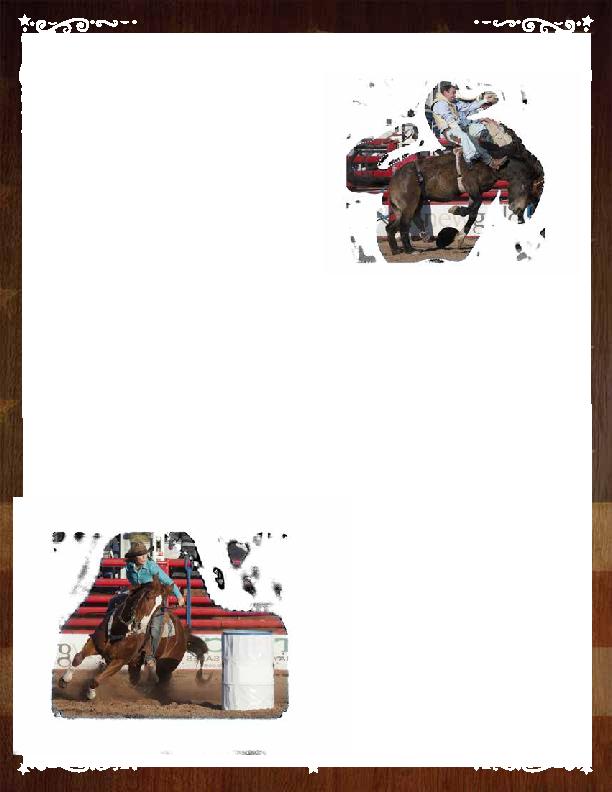
Brawley Chamber of Commerce
Brawley Cattle Call
48
Bareback Riding
Most cowboys agree that bareback riding is the most physically demand-
ing event in rodeo, taking an immense toll on the cowboy's body. Muscles are
stretched to the limit, joints are pulled and pounded mercilessly, and ligaments
are strained and frequently rearranged. The strength of bareback broncs is
exceptional, and challenging them is often costly.
Bareback riders endure more abuse, su er more injuries
and carry away more long-term damage than all other rodeo
cowboys.
To stay aboard the horse, a bareback rider uses a rigging
made of leather and constructed to meet PRCA safety speci cations.
The rigging, which resembles a suitcase handle on a strap, is placed
atop the horse's withers and secured with a cinch.
As the bronc and rider burst from the chute, the rider must
have both spurs touching the horse's shoulders until the horse's feet hit
the ground after the initial move from the chute. This is called "marking out". If the cowboy fails to do this, he is
disquali ed.
As the bronc bucks, the rider pulls his knees up, rolling his spurs up the horse's shoulders. As the horse
descends, the cowboy straightens his legs, returning his spurs over the point of the horse's shoulders in antici-
pation of the next jump.
Making a quali ed ride and earning a money-winning score requires more than just strength. A
bareback rider is judged on his spurring technique, the degree to which his toes remain turned out while he is
spurring and his willingness to take whatever might come during his ride. It's a tough way to make a living, all
right. But, according to bareback riders, it's the cowboy way.
Barrel Racing
Barrel racing has no judges, which means the event has no subjective points of view. Time is the deter-
mining factor. Barrel racing is grate l and simplistic - one woman, three barrels, a horse and the ever-present
stopwatch. The horse is ridden as quickly as possible around a cloverleaf course of three barrels. At the end of the
performance, after all of the racers have nished their runs, the clock is the one and only judge.
Ride quickly and win. Hesitate and lose. Not only have the best of the sport spent countless hours
practicing and honing their skill, but they also have invested many dollars in the purchase and maintenance of the
talented horses they ride. A proven barrel racing horse can cost $50,000. For the
professional barrel racer, this is indeed a small price to pay:
Not only must the horse be swift, but also must be intelligent enough to avoid
tipping the barrels, an infraction that adds ve penalty seconds to the time and
kills any chance for victory.
The horse also must be able to withstand the long roads a cowgirl
must travel to reach the next rodeo. If a horse is fast, competitive and
reacts calmly to the demands of travel, chances are good that horse can
stop the clock as quickly or quicker than the animal in the next trailer.
Because so many barrel racers have nely tuned their skill, the sport is
timed to the hundredth second. When the racer enters the arena, an
electronic eye starts the clock. The clock is stopped the instant the horse
completes the pattern.
Barrel racing at its core has changed little from the days when cowgirls
raced for minimal, if any, prize money and support. And though the prizes
and exposure are greater now than ever, the ultimate goal remains
essentially the same as in the past: stop the clock as quickly as possible.

